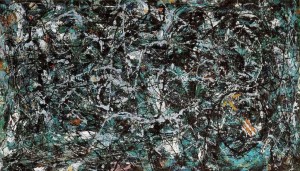Remembering Jackson Pollock

Influential Abstract Expressionist painter Paul Jackson Pollock was born on January 28, 1912 in Cody, Wyoming. With his father, a farmer and government surveyor, mother and four brothers, Pollock grew up in Arizona and Chico, California.

While living in California, he enrolled at Los Angeles’ Manual Arts High School, from which he was expelled, after having been expelled from another high school in 1928. In 1930, following his brother Charles Pollock, he moved to New York City. Jackson Pollock soon began studying with Charles’ art teacher, representational regionalist painter Thomas Hart Benton, at the Art Students League. Benton’s rural American subject matter shaped Pollock’s work only fleetingly, but his rhythmic use of paint and his fierce independence were more lasting influences. Pollock spent much of his time with Benton, often babysitting Benton’s young son, and the Bentons eventually became like the family Pollock felt he never had.

In 1935 Pollock and his brother Charles moved in together, living in a small, cheap, unheated apartment at 46 East 8th Street. When Charles and his wife moved out, Pollock’s lover Lee Krasner moved in. Pollock also briefly lived at an apartment on 46 Carmine Street in the 1940s, which is within the South Village Extension of the Greenwich Village Historic District of which we secured designation in 2010.

Exactly how Jackson Pollock’s famous drip technique developed has been a matter of long and inconclusive scholarly argument, but his work was already taking steps towards it in the mid-1940s. At this time, Pollock began to lose the symbolic imagery of his earlier pictures and looked for more abstract means of expression. In the following years his style continued to become more and more abstract, exemplified by works like Shimmering Substance (1946). The following year he finally hit on the idea of flinging and pouring paint, and thus found the means to create the light and airy webs of color that he was reaching towards; masterpieces such as Full Fathom Five (1947) were the result. Pollock had arrived at a unique method that combined Impressionism, Surrealism and Cubism.

Throughout his life Jackson Pollock enjoyed considerable fame and notoriety. He was regarded as a mostly reclusive artist with a volatile personality who struggled with alcoholism. His wife and fellow artist Lee Krasner was an important influence on his career and legacy. Pollock died in an alcohol-related car accident on August 11, 1956 at the age of 44. In December of that year, he was given a memorial retrospective exhibition at the Museum of Modern Art (MoMA) and a larger more comprehensive exhibition at MoMA in 1967. He has had hundreds of shows and large-scale retrospectives throughout the world, and today, Jackson Pollock is considered one of the most famous twentieth century American artists.
Like generations of artists, writers, actors, and other creative types before and after him, Jackson Pollock’s legacy continues to live on in the Village.
Read more “Off the Grid” Posts on Jackson Pollock here.

Pollock lived at 46 Carmine Street in 1932, while he was studying with Benton–long before he began to develop his famous pouring technique. He lived with Charles at 46E8 for a short time in 1933, then he and another brother, Sanford, moved in when Charles moved out in 1935.